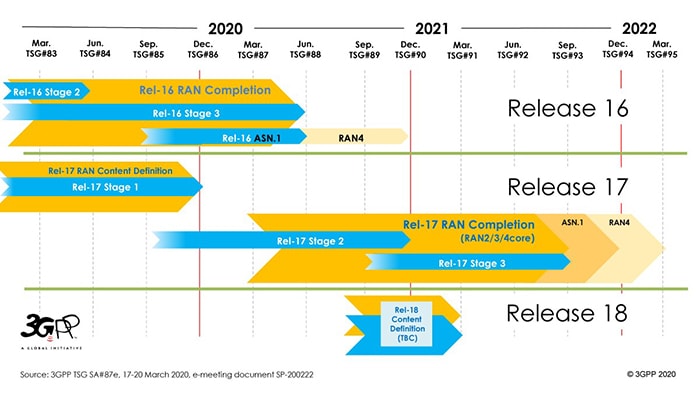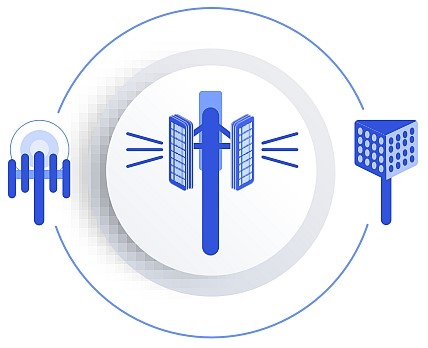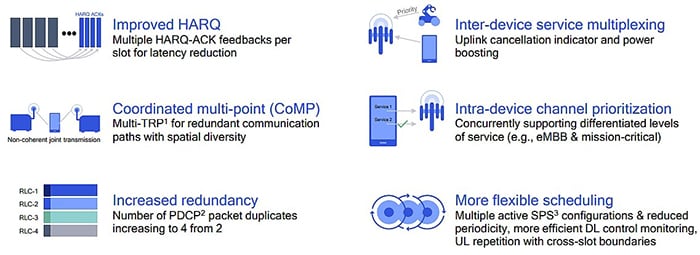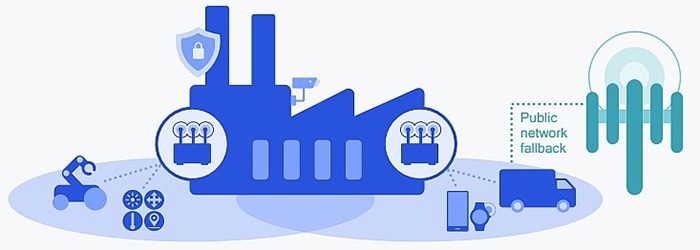What's 3GPP 5G Release 16 All About?
Image Source: Andrey Suslov/Shutterstock.com
As you read this, 5G is rolling out across the United States. Some people have a 5G compatible phone that can connect to an AT&T network, T-Mobile, or Verizon. T-Mobile was the first carrier to deploy a nationwide 5G network, but only in the sub-6GHz spectrum, and slower than an optimum mmWave speed will ultimately be. AT&T has the largest network, which is mostly composed of a sub-6GHz spectrum operation. Many of these networks have only sub-6GHz spectrum capability now with speeds the same as 4G. Verizon has the most widespread mmWave network, but it does not yet work at optimum performance levels.
Take heart, cellphone users. Slow rollouts happened in 4G, 3G, and prior rollouts. Patience is needed. We will get there, and when we do, the world as we know it will change drastically for the better.
Let’s see where we are today in 5G technology with the latest 3GPP 5G release 16 completed on July 3, 2020.
What Exactly is a 3GPP 5G Release?
3GPP uses a system of parallel Releases that provide developers with a stable platform for the implementation of features at a given point and then allow for the addition of new functionality in subsequent releases.
Essentially, new technologies for 5G are maturing. When a technology, such as Vehicle-to-everything (V2X) or Multiple User-Multiple Input Multiple Output (Mu-MIMO), reaches another growth point in its mature development, 3GPP advises developers in a Release to proceed with that present stable implementation and can incorporate it into their system.
The Excitement of 5G Release 16
Release 16, centered on industry expansion, is called 5G phase 2. Let’s see what this all means, as far as where we are, in the pursuit of a fully operational 5G system (Figure 1).

Figure 1: 5G Release 16, 17, and 18 timelines (Source: 3GPP)
3GPP 5G Release 16 will enable enterprises and industrial organizations, from manufacturers to healthcare, to access the functionalities that will allow them to move forward with new levels of automation, efficiency, and service.
Six Important Aspects of 5G Release 16
5G New Radio (NR) Enhancements
MU-MIMO
With MU-MIMO, a base station can send multiple data streams, one for each User Equipment (UE), via the same time-frequency resources. MU-MIMO enables an increase in the total cell throughput/cell capacity. The base station will have multiple antenna ports, as many as there are UEs, which will be receiving data simultaneously. One antenna port is needed in each UE.

Figure 2: MU-MIMO sending multiple data streams, one for each UE, via the same time-frequency resources (Source: Qualcomm)
Essentially, more antennas will be deployed to achieve large gain from receive diversity and MIMO.
Multiple transmission and reception points (Multi-TRP)
These are macro-cells, small cells, pico-cells, femto-cells, remote radio heads (RRH), relay nodes, and more. Multi-TRP will improve reliability, coverage, and capacity performance via a mix of the above-mentioned flexible TRPs. This will enable exponential growth in 5G mobile data traffic, for example, when a wireless device at the cell edge can be served by multi-TRPs that will improve its signal transmission/reception, leading to increased throughput.
Better Link Reliability
Release 16 enables enhanced 5G Ultra-Reliable Low-Latency Communication (eURLLC) foundation to deliver even better link reliability (as high as 99.9999 percent) (Figure 3)

Figure 3: 5G Release 16 enhanced Ultra-Reliable, Low-Latency Communication (eURLLC) building upon the Release 15 URLLC foundation (Source: Qualcomm)
With IAB, not every small cell must have fiber going to it. Traditional fiber backhaul is costly. Also, using fiber to each cell site might not always be possible in many cases. Now, with Release 16, wireless radio connections can be used. mmWave backhaul will have more extended range when compared to traditional access. Finally, mmWave access and backhaul have the flexibility to share common resources.
2) Integrated access and backhaul (IAB)
The IAB network is a cost-effective deployment option that will densify networks without the overhead of growing wired transport proportionally. Release 16 enables cost-efficient dense deployments. Coverage and capacity will be improved while lowering the cost of backhaul (Figure 4).

Figure 4: Release 16 also addresses standards for IAB, using part of the 5G radio for backhaul (Source: Qualcomm)
With IAB, not every small cell must necessarily have fiber going to it; traditional fiber backhaul is costly. Also, using fiber to each cell site might not always be possible in many cases. Now, with Release 16, wireless radio connections can be used. mmWave backhaul will have a longer range when compared to traditional access. Finally, mmWave access and backhaul have the flexibility to share common resources.
3) 5G in the Unlicensed Spectrum
Release 16 is the first occasion in which unlicensed spectrum has been included in the 5G cellular service.
More spectrum globally will be unlocked, will enable new markets and verticals, and can achieve new deployment scenarios (Figure 5).

Figure 5: Release 16 introduces NR, for the first time, in the unlicensed spectrum. NR-U is New Radio-Unlicensed (Source: Qualcomm)
Work presently in progress to specify NR enhancements for a single global framework will allow access to unlicensed spectrum that will enable NR operation in 5GHz and 6GHz (for example, US 5925-7125 MHz, or European 5925-6425 MHz). NR-U should enable fair coexistence with already deployed IEEE 802.11/Wi-Fi systems.
4) 5G in Time-sensitive Networking (TSN)
TSN over 5G networks is a requirement for industrial automation and other IoT applications. Let’s look at the Integration of TSN into applications with high demands on time synchronization. Such applications as mobile robots’ cooperative work with platooning, cooperative transport of goods on a smart factory floor, and other industrial mobile use cases are some prime areas for TSN.
In the realization of mobile use cases, wireline technologies cannot be used and must be replaced by wireless connections, which have to meet the high demands of the industrial landscape (Figure 6).

Figure 6: 5G, Release 16, brings support for TSN. Figure 6, reference 1 states that “the TSN network is controlled by a Central Network Controller (CNC). TSN and CNC are defined in a set of standards specified by IEEE 802.1AS” (Source: Qualcomm)
5G TSN adapters also enable the 5G wireless system to act as a TSN bridge with Ethernet connectivity. There will be precise time synchronization with generalized Precision Time Protocol (gPTP) at microsecond levels. This 5G, Release 16, wireless technology will enable traditional mobile broadband to rise to a new level regarding data rates, capacity, and availability.
Looking at the most significant features, we have divided them into three parts:
- The massive Internet of Things (IoT), which is also known as massive machine-type communications (mMTC)
- Ultra-reliable low-latency communication (URLLC)
- Enhanced mobile broadband (eMBB). This wireless technology will advance traditional mobile broadband to a new level in terms of data rates, capacity, and availability.
5) C-V2X Sidelinking with 5GNR
Release 16 NR C-V2X direct device-to-device communication mode (or sidelink) specifications will support advanced use cases that could enhance autonomous driving without using the cellular network. Sidelinking is essential because some V2X services just have proximity interest and need to keep operating even in spotty network coverage situations.
In today’s 5G era, automotive and transport industries are moving toward an intelligent transport system (ITS), enabling many benefits, including improved safety, reduced traffic congestion, optimum fuel consumption, and a positive environmental impact. V2X communication is a key enabler of emerging ITS applications, which will allow vehicles to communicate with other vehicles, pedestrians, road infrastructure, and the internet (Figure 7).

Figure 7: Sidelink is essential for such use cases as public safety and data offload. (Source: Qualcomm)
Release-16 NR cellular interface and the NR sidelink interface are designed to enable platooning, advanced driving with such features as collision avoidance and cooperative lane change, extended sensors, and remote driving use cases.
Using V2X communication, real-time data related to overall traffic situations is collected and exchanged among users. This will enable safer, more coordinated, and smarter use of transportation networks.
For use cases that will require very low latency and high reliability–referred to as ultra-reliable low-latency communication (URLLC) applications–the 3GPP has improved the latency and reliability of the cellular interface in Rel-16.
Table 1:Requirements and potential technologies for V2X use cases considered in 3GPP (Source: Reference 5)

URLLC-related features for a cellular interface are being developed in the URLLC in Rel-16. Reference 5 lists these features, including:
- Enhancements to uplink configured grants as well as downlink semi-persistent scheduling with multiple configurations that will allow UE to transmit or receive as soon as possible
- Enhancements to the downlink control channel information to allow a more robust transmission
- Enhancements to the uplink control channel to enable multiple hybrid automatic repeat request (HARQ) acknowledgments within a slot for faster HARQ feedback
- Enhancements to the uplink data channel to support the repetition of short transmissions within a slot and across slot boundaries for lower latency while ensuring high reliability
- Procedures of intra-UE and inter-UE packets’ prioritization to facilitate the transmissions of latency-critical packets
All the above enable faster data transmissions and HARQ acknowledgements in the uplink/downlink reducing latency and increasing the reliability of the communications.
6) 5G in IoT/NB-IoT within 5GNR
Release 16 provides the ability to deploy and manage low-power mobile IoT protocols such as NarrowBand-Internet of Things (NB-IoT) over the 5G core network.
NB-IoT is a standards-based, low-power wide-area (LPWA) technology developed to enable a wide range of new IoT devices and services. This technology greatly improves user devices’ power consumption, system capacity, and spectrum efficiency, especially in deep coverage situations. A battery life of more than 10 years can be supported for several use cases (Figure 8).

Figure 8: A private network or non-public network will benefit from an industrial IoT case (Source: Qualcomm)
Benefits are a local dedicated network, dedicated resources, and independent management. The system is secure with cellular-grade security; sensitive data remains on premises. Finally, this system is optimized with a tailored performance for local applications with low latency, Quality of Service (QoS), and application programming interfaces (APIs) for managed third-party access.
Conclusion
5G brings to the party indoor and outdoor coverage, high data speeds, seamless handovers, and a public network fallback. 5G also provides industrial-grade reliability, latency, and synchronization (eURLLC and TSN). And finally, 5G brings interoperability with a global-standard vast ecosystem that is future proof with a promising 5G roadmap.